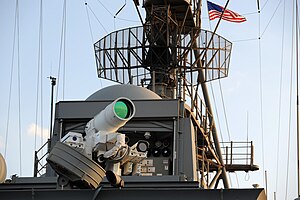Laser Weapon System
| Laser Weapon System | |
|---|---|

The Laser Weapon System (LaWS) aboard USS Ponce.
|
|
| Type | Directed-energy weapon |
| Place of origin | United States |
| Service history | |
| In service | 2014–present |
| Used by | US Navy |
| Production history | |
| Designed | 2010–14 |
| Manufacturer | Kratos Defense & Security Solutions |
| Number built | 1 |
The AN/SEQ-3 Laser Weapon System or XN-1 LaWS is a directed-energy weapon developed by the United States Navy. The weapon was installed on USS Ponce for field testing in 2014. In December 2014, the United States Navy reported that the LaWS system worked perfectly, and that the commander of the Ponce is authorized to use the system as a defensive weapon.
The LaWS is a ship-defense system that has so far publicly engaged an unmanned aerial vehicle (UAV or drone) and a simulated small-boat attacker. LaWS uses an infrared beam from a solid-state laser array which can be tuned to high output to destroy the target or low output to warn or cripple the sensors of a target. Among the advantages of this device versus projectile weapons is the low cost per shot, as each firing of the weapon requires only the minimal cost of generating the energetic pulse; by contrast ordnance for projectile weapons must be designed, manufactured, handled, transported and maintained, and takes up storage space.
The LaWS is designed to be used against low-end asymmetric threats. Scalable power levels allow it to be used on low-power to dazzle a person's eye to non-lethally make them turn away from a threatening posture, and increase to 30 thousand watts (30 kW) to fry sensors, burn out motors, and detonate explosive materials. Against a vital point on small UAVs, one can be shot down in as little as two seconds. When facing small boats, the laser would target a craft's motor to disable it and make it "dead in the water," then repeating this against others in rapid succession, requiring only a few seconds of firing per boat. Targeting the platform is more effective than individual crewmembers, although the LaWS is accurate enough to target explosive rockets if on board, whose detonations could kill the operators. Against larger aircraft like helicopters, it is able to burn through some vital components, which would cause it to fall and crash.
In 2010, Kratos Defense & Security Solutions was awarded an 11-million-dollar contract to support the Naval Surface Warfare Center (NSWC) in the development of LaWS for the U.S. Navy's Directed Energy and Electric Weapon Systems (DE&EWS) program. The May 2012 NSWC test used a close-in weapon system control system to enable the beam director to track an unmanned aerial vehicle target.
...
Wikipedia
